Euntes Docete Omnes Gentes
Published in 18th-19th Century Social Perspectives, 18th–19th - Century History, Features, Issue 3 (Autumn 2000), The Famine, Volume 8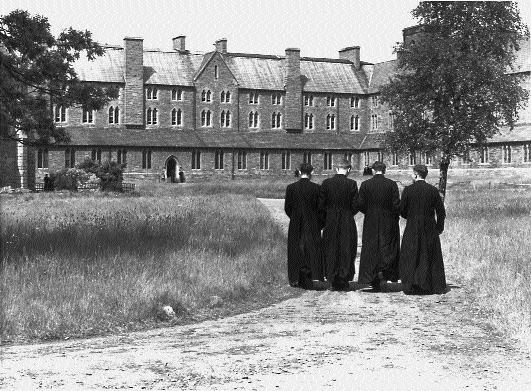
‘Go teach all nations’-All Hallows College, Dublin, 1950s-founded with the primary purpose of educating priests for service abroad. (All Hallows College)
Irish missionary effort in America began before the Famine, when most Irish immigrants were non-Catholic, but it matured quickly thereafter between 1845 and 1900 when approximately four million Irish, predominantly Catholic, left their homeland for the United States. Prior to the Famine, priests from the Irish colleges of Spain, especially Salamanca, came to serve in the Spanish missions of Florida and Louisiana. Irish-born priests began to emigrate to America in the last two decades of the eighteenth century and by the beginning of the nineteenth, they began to challenge English- and French-born priests for control of the nascent American church.
Surplus of clergy in Ireland
Vocations to the priesthood and the religious life increased dramatically in Ireland during and after the Famine as a result of the Devotional Revolution and the Roman Catholic church had more clergy than they needed for their various parishes and religious institutions. With plenty of priests for the home missions, Irish seminaries began to educate priests for the foreign missions. The surplus of priests and seminarians was a blessing for the United States, Canada, Britain, Australia, and a variety of other countries lacking native-born clergy and dependent on foreign-born clergy. Britain in particular benefited immensely by its proximity to Ireland and the largess of Irish Catholicism. According to Bernard J. Canning, more than 1,360 Irish secular priests have served just in Scotland alone from 1829 to 1979, with at least fourteen eventually transferring to dioceses in the United States.
In the United States, Irish immigrants demanded that Irish-born priests be assigned to their parishes. Richard Purcell writes, ‘In Ireland and in Irish colonies in America, it was believed that Irish priests must be obtained to manage their countrymen and to preach in the English tongue’. American bishops, a growing number of whom were Irish-born or of Irish heritage, recruited priests from Irish seminaries as well as other priests from throughout Europe for their dioceses. The conventional wisdom of the time was that other foreign-born priests would most likely want to assist their fellow countrymen in America not the recent Irish immigrants and that the Irish-born priests, since they spoke English, would blend more easily into American society than those from France, Germany or Austria.
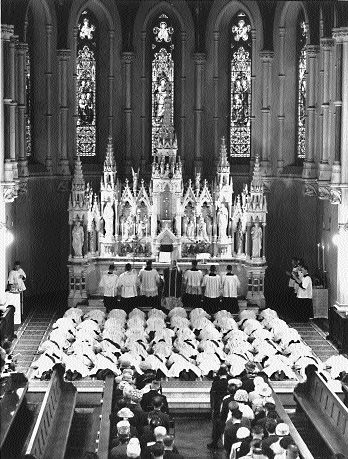
The class of ‘52-All Hallows ordinations conducted by the Bishop of Achonry. (All Hallows College)
‘Train them up and send them out’
Bishop John England, a native of Ireland and educated at St Patrick’s College, Carlow, was appointed the first Bishop of Charleston, South Carolina, in 1820 and served there until his death in 1842. England recruited priests and seminarians from Ireland and met with Irish bishops requesting their continued assistance until an American-born and American-trained clergy could be established. This was the dream of the first Bishop of Baltimore and the United States, John Carroll, who was an English Jesuit of Irish descent. Bishop England sought Irish women for an order of nuns he was starting in his diocese as well as men for a seminary he was establishing in Charleston. Other prelates depended on Irish seminaries for priests. On 20 February 1860 Bishop William Henry Elder wrote from Natchez, Mississippi, to All Hallows College:
I have just been rejoiced with the offer of that good, charitable, Irish Catholic gentleman to pay the pension of two students at All Hallows for the diocese of Natchez…I have acquaintance with him. He says he was led to propose this work of charity from reading your report and my letter. After I wrote to you from Houston last October, I heard of some Irish Catholics living far out of my intended line of travel. I went to look for them and reached some. The others I could not get to without failing in my appointments. I baptised children four years old, who had never been seen by a priest, and blessed marriages which had been made three years ago before a magistrate for want of a priest…
And then the poor Negroes—they are more than half of our whole population—and we have scarcely begun to do anything for them. You see, we want priests, and real apostolic priests, none others. Train them up and send them out to us, and you will have a large share of their merits and rewards. Meanwhile, pray for us. Giving my blessing to the young men who are preparing for Natchez, and indeed, to all your college.
Bishop Francis X. Gartland of the diocese of Savannah, Georgia, wrote to All Hallows College in 1851:
I have but nine priests to minister to the wants of a widely scattered Catholic population. The missions are generally poor, the climate in most places excessively warm for four months in the year, so that we have few or no temporal advantages to induce missionaries to come amongst us…Many, nay vast numbers of the children of poor immigrants from Ireland have fallen away from the faith of their ancestors throughout every part of this country, in consequence of the immigrants having, often through dire necessity, located themselves in districts where there were no priests and no church at hand.
Many aspiring priests jumped at the opportunity to follow family members and countrymen to the United States and volunteered or sought out bishops for sponsorship in the seminary. American bishops ‘adopted’ or paid the account or pension of the Irish seminarians in exchange for their services to the diocese once ordained to the priesthood. A very common story told by Irish priests in America is stated by Thomas P. Cahalane who was ordained in Ireland in 1963 for the diocese of Tucson: ‘I had a desire to be a priest since high school, but not necessarily for the home missions. My sense was that there was a glut of priests in Ireland; we were overstocked’.
Irish clergy dominant in US church
While the vast majority of emigrant Irish priests were secular (diocesan), some were members of religious orders such as the Augustinians, Dominicans, Capuchins and Franciscans. Richard Arthur, a Franciscan, is assumed to have been the first Irish priest, arriving in 1597, to minister to the people in what is now St Augustine, Florida. As Roger Finke and Rodney Stark state, ‘Without these Irish “imports” it is hard to imagine how churches could have met their staffing needs’. By the mid-1800s, 59 per cent of the priests in the diocese of New York were Irish-born and at the beginning of the twentieth century, 62 per cent of the bishops were Irish-American. More than half of them were Irish-born. One-third of the pastors in the archdiocese of San Francisco in 1963 were born and educated in Ireland, while during the 1940s and 1950s, 80 per cent of the priests in the archdiocese of Los Angeles were Irish-born. By 1966, the archdiocese of Miami was home to eighty-one Irish-born priests, the largest group of priests in the archdiocese at that time.
Irish priests in the United States are a dying breed, yet they still play a significant role today. Almost one-third or nineteen of the sixty priests in the diocese of Savannah, Georgia, are Irish and nearly one-fourth (forty out of 186) of the priests in Georgia (which includes the archdiocese of Atlanta and the diocese of Savannah) are Irish. Records indicate that approximately 4,000 Irish priests have served in the United States and somewhere near 1,250 are currently affiliated with American dioceses.
The flow of priests from Ireland to America has essentially ended. There might be several ordinations a year for American dioceses but the once priest-rich Ireland is no longer providing diocesan clergy for the United States. Seminary enrolments in the United States have plummeted since Vatican II and in Ireland declining vocations have precipitated the closure of several seminaries. Since there is no longer a surplus of priests in Ireland, Irish dioceses are less likely to loan priests or encourage bishops from outside of Ireland to recruit seminarians for their dioceses.
Irish seminaries
Six Irish seminaries have provided the majority of Irish priests for American dioceses: All Hallows, Dublin; St Patrick’s, Carlow; St Patrick’s, Thurles; St Peter’s, Wexford; St John’s, Waterford; and St Kieran’s, Kilkenny. The last three are now closed. All Hallows at present has no-one studying for the priesthood. St Patrick’s College, Maynooth is the national seminary and its graduates are usually affiliated with Irish dioceses, although some have been educated for dioceses outside of Ireland,
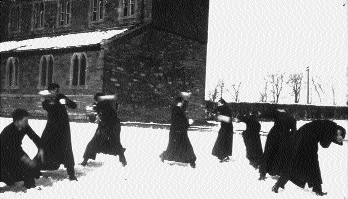
All Hallows seminarians enjoy a lighter moment. (All Hallows College)
including the United States. Some Irish priests who eventually served in America received their secondary education at a variety of Irish junior seminaries or diocesan colleges before proceeding to one of the above mentioned major seminaries for a few years and then finishing their major seminary requirements in the United States. In the late 1800s and into the early 1900s Bishops Moore and Kenny of the diocese of St Augustine, Florida, recruited heavily from the lesser known Mungret College, Limerick, and run by the Jesuits for those with late vocations.
All Hallows
All Hallows was founded with the primary purpose of educating priests for service abroad. All Hallows has educated the largest contingent of Irish priests to serve in America. The remaining seminaries, excluding Maynooth, are local diocesan seminaries. They educated priests for service in the home missions and those not selected to serve at home or who were eager to leave Ireland were usually sponsored by dioceses outside Ireland.
Of the 1,404 priests that came to America from All Hallows the largest contingent arrived between 1949 and 1965 and the second largest group came between 1891 and 1911. Between 1842 and 1911 the majority of priests resided in New England, the mid-Atlantic states, and the Midwest. This geographic distribution is not surprising since that is where the bulk of the US population lived at the time, but by 1912 and continuing throughout the century, California became the major destination for All Hallows priests. Dioceses in California and throughout the West did not produce enough native vocations to meet the rising demand for priests brought about by the westward expansion of the population. Graduates from All Hallows serving in California outnumbered all other Californian diocesan priests until the 1990s. The South, particularly Florida and Georgia, has experienced exponential growth since mid-century and a large number of All Hallows graduates have also served dioceses in this region.
St John’s, Waterford
Of the 244 priests that were ordained for American dioceses from St John’s, Waterford, the majority have served in the South and the West. The largest cohort of priests came between 1961 and 1970 and the second largest arrived between 1916 and 1930. The archdiocese of Los Angeles has been home to the greatest number of alumni, while the majority of alumni today can be found in California, Florida, Texas, New Jersey, Georgia, and New York.
St Peter’s, Wexford
St Peter’s, Wexford has educated 163 priests for American dioceses, ninety-four of whom at present reside in eighteen different states with the largest concentrations in California, Florida and Texas. Dioceses that have received the most priests are Camden (New Jersey), Los Angeles, Mobile and Birmingham (Alabama), now separate dioceses, and San Diego.
St Patrick’s, Carlow
Next to All Hallows, St Patrick’s, Carlow has produced the largest number of priests for service in America. One thousand and forty-three Carlow men have served primarily in the West and South. The archdiocese of Los Angeles has had the largest concentration.
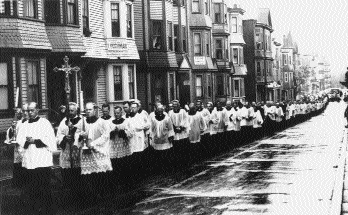
A procession through Roxbury, Massachusetts, 1954. (Archdiocese of Boston)
As of 1997, 254 alumni reside in twenty-four states including large concentrations in Mississippi, California, Florida, New Jersey, Texas, Arizona, Alabama, Louisiana, and Georgia.
St Patrick’s, Thurles
Five hundred and eleven alumni from St Patrick’s College, Thurles have served in a variety of dioceses throughout the United States. Dioceses in California, Florida and Montana have been home to the most graduates. As of 1997, 176 alumni are affiliated with forty-eight dioceses and the largest concentrations are located in Sacramento, Los Angeles, and Great Falls (Montana).
St Kieran’s, Kilkenny
Somewhere near 550 priests educated at St Kieran’s, Kilkenny, have served in the United States. Almost half of them have been located in just three states, California, Florida, and Georgia.
Maynooth
Even though St Patrick’s College, Maynooth is the national seminary it still has prepared eighty-eight men for the priesthood in the United States. Fourteen were ordained between 1795 and 1895 for the dioceses of Denver, Dubuque (Iowa), New York, Omaha, Pittsburgh, Rochester and Sacramento and seventy-four were ordained between 1895-1997 for the dioceses of Atlanta, Brooklyn, Birmingham, Camden, Cheyenne (Wyoming), Davenport (Iowa), Detroit, Duluth (Minnesota), Fargo (North Dakota), Great Falls, Kansas City, Los Angeles, Miami, Mobile, Monterey-Fresno (now separate dioceses), Natchez-Jackson (now Jackson), Omaha, Philadelphia, Richmond (Virginia), Sacramento, San Diego, San Francisco, Santa Rosa, St Augustine, St Paul/Minneapolis, St Petersburg, Salt Lake, San Francisco, Savannah, Seattle, Springfield (Illinois), Washington and Wheeling (West Virginia).
Maynooth alumni were represented among the Catholic hierarchy in America during the middle to late nineteenth century—Peter Richard Kenrick of St Louis, Eugene O’Connell of Oregon, Patrick Feehan of Chicago, Tobias Mullen of Erie, Thomas Hendriken of Providence, and Eugene Conwell of Oregon. The coadjutor to Bishop John England of Charleston, South Carolina was William Clancy, a Maynooth graduate.
In addition to these bishops, several other Irish priests have served as bishops in the United States. Even though the Vatican rarely appoints Irish-born priests as bishops today, because the preference is for native-born clergy, they are still represented among the American hierarchy—John Kevin Boland of the diocese of Savannah, Raymond Boland of the diocese of Kansas City-St Joseph, and Thomas Curry of the archdiocese of Los Angeles, all alumni of All Hallows; Edmond Carmody of the diocese of Corpus Christi, an alumnus of St Patrick’s, Carlow; Patrick J. McGrath of the diocese of San José, an alumnus of St John’s, Waterford; and Anthony O’Connell of the diocese of Palm Beach, who is Irish-born but educated at Kenrick seminary, St Louis.
Reports from abroad
The archives of Irish seminaries contain some fascinating insights into the mindset of Irish priests and their reactions to what they encountered in the United States and elsewhere. The following quote is from a letter written in 1860 by an alumnus of All Hallows who was stationed in Atlanta, Georgia, which at that time was in the diocese of Savannah:
Northern Georgia, in which my mission is at present, is an elevated country, and I believe there is no more healthy country to be found. As a fertile country, it is doubtless much inferior to Ireland; but, considered as a healthy country, I believe it much superior to Ireland. We know nothing here of moist atmosphere; once the shower is over, the sky becomes clear and the atmosphere bracing. This, I presume, accounts for the fact that we are strangers to the hollow coughs, the fatal colds, the consumptions, and the asthmas, which any unprejudiced eye can see very frequently all over Ireland…The truth is, I would not like to leave Georgia… Our greatest difficulty in Georgia is, that the Catholics are much scattered. This causes a great deal of travelling; but the travelling, so far from being a labour, is in my opinion, healthful and invigorating…I hope that you will be able to state to us soon that you have adopted for our diocese three students who have entered the theology class.
American bishops were constantly reminding the rectors of the Irish seminaries that they did not want sickly seminarians adopted for their dioceses. Due to the incidences of tuberculosis in Ireland, American bishops were suspicious that some seminarians were more interested in coming to America for health reasons than for serving as priests. Further on in the letter, the author refutes the claim that yellow fever was rampant in Georgia. In reality cholera, yellow fever and typhus did take its toll on both clergy and parishioners in the South. Not only were bishops concerned about the health of the seminarians they had adopted for their dioceses, some went as far as to request that they refrain from alcohol and take the temperance pledge.
The following is from a letter written a century later in 1968 for Petrus, a college annual, by an alumnus from St Peter’s, Wexford:
I was introduced to my first Southern breakfast—it was simply awful. It consisted of real strong coffee, French bread and grits (a type of rice). I told the housekeeper who was an old Negro lady called Sarah (who was a Baptist) that I like tea, toast and corn flakes, and plenty of potatoes for dinner. Immediately she almost changed her colour, and with both hands on her hips she replied with great vigour in the real Southern Negro accent, ‘Sir, you is gonna have to eat our Southern dishes if you is gonna stay in dis house’.
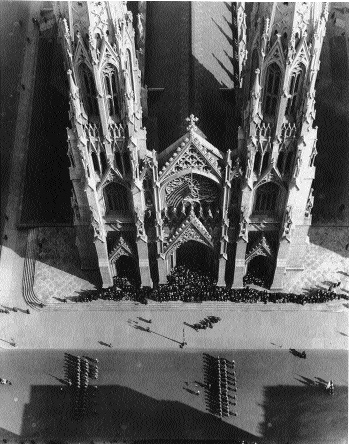
The St Patrick’s Day parade marches past St Patrick’s Cathedral, New York-by the mid-1800s, 59 per cent of the priests in the diocese of New York were Irish-born. (Bettman Archive)
On another issue this newly ordained priest wrote:
Having read the gospel, I took a deep breath and glanced down the church. I began to introduce myself, and having done this I felt a little more at ease, and then delivered my sermon. Having finished I was glad when nobody stood up to criticise it. In the seminary I once heard about an American coming into the sacristy to tell the priest how poor his sermon was. With this in mind I expected the whole congregation to turn up to tell me to improve. However this did not happen. I now find that an American congregation is as easy to preach to as an Irish one. You still have to preach in the simplest of terms.
Culture shock
Contemporary Irish priests, as a whole, speak very highly of the education they received at Irish seminaries, especially their theological and philosophical preparation. All agree that they were not prepared to deal with American culture. Most of them lacked an understanding of American history and even though they spoke English, they were unfamiliar with the regional accents and American slang. Until the last several decades, it was unusual for Irish seminarians to have some type of internship experience or spend some time as a deacon in the United States prior to their ordination. Those who have been fortunate to have had these experiences report they adjusted earlier to the American way of life.
William L. Smith is Professor of Sociology at Georgia Southern University.
Further reading:
K. Condon, The Missionary College of All Hallows 1842-1891 (Dublin 1986).
T.T. McAvoy, ‘The Irish Clergyman’ in A History of Irish Catholicism, vol. VI (Dublin 1970).
W.L. Smith, ‘Irish Priests and American Catholicism: a match made in heaven’ in J.M. Greer and D.M. Moberg (eds.), Research in the Social Scientific Study of Religion, vol. 9 (1998).
W.L. Smith, ‘Contemporary Irish Priests in America’ in J.M. Greer and D.M. Moberg (eds.), Research in the Social Scientific Study of Religion, vol. 11 (2000).
















